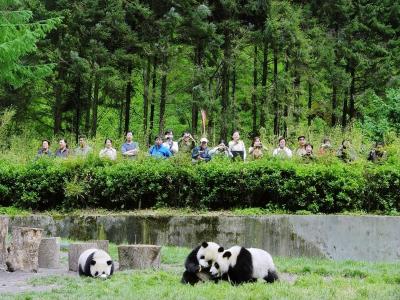New science redefines remote - even pandas global
Add Summary

This just in from the pandas nestled in a remote corner of China: Their influence spans the globe.
In this week’s international journal Ecology and Society, sustainability scholars from Michigan State University apply a new integrated framework to the decades of work they’ve done to understand how pandas and local people in pandas’ fragile environment interact across the world.
The results, with implications far beyond panda conservation, are a bit mindboggling. From economic impacts in cities like San Diego and London to crops in Memphis to global greenhouse gases, the framework of telecoupling (socioeconomic and environmental interactions over distances) lays out a dynamic, complex view of how issues of sustainability reach across the world – and then impacts rush back. And effects spring up along the way.
Understanding the minutia is important to sustainability, says lead author Jianguo “Jack” Liu, the Rachel Carson Chair in Sustainability at Michigan State University (MSU), because policies intended to improve the world’s environment or save rare animals aren’t supposed to cause damage in other places.
“In this new world of hyper connectivity, even remote areas like the Wolong Nature Reserve are connected in so many ways. If we’re going to understand the world fully, and advise policy makers well, science needs to make the big picture as specific and detailed as possible."
Loan a panda, have global impact
So Liu, the director of MSU’s Center for Systems Integration and Sustainability, and his colleagues across the United States and China, hunkered into the task of showing how pandas in the mountains of southwestern China affect the globe, and vice versa.
United States and China, hunkered into the task of showing how pandas in the mountains of southwestern China affect the globe, and vice versa.
Their paper “Multiple Telecouplings and their Complex Interrelationships” does a deep dive into the two-way superhighway of trade, economics, physical sciences and environmental ups and downs between Wolong and the rest of the world.
For example: panda loans. The cuddly iconic bears from Wolong have gone to seven cities in five countries
across the world, usually for fees and often carrying diplomatic and public relations good will in both directions. The scientists identify not just those points, but zero in on the juggernaut of people involved in negotiating and facilitating the arrangements and the economic benefits and costs – from increased donations to zoo attendance to operational and training expenses.
Then the paper dives deeper. The scientific collaborations and conservation efforts expand as the pandas span out. The carbon emissions soar as pandas get new homes. For instance, a panda pair that was resettled on loan in Edinburgh, Scotland, not only spewed out some 232,000 kg of CO2 from the Boeing 777 they took from Chengdu to Scotland, but Edinburgh didn’t have enough bamboo. That meant the jet originated in Memphis, where it loaded up on bamboo before swinging by to pick up the bears. That’s an additional 12,550 km and more than 360,000 kg of CO2. Then there are the impacts of tourist visits, additional staffing and training. At each segment of the panda’s path, more effects register, if one looks for them.
It makes any discussions of panda loans – or the future of panda loans – much richer than a simple yes/no consideration. Liu also noted that the telecoupling framework has the potential to extract important understandings from the 2008 Wenchuan earthquake that devastated much of the area in and around Wolong.
“The earthquake became almost like a natural laboratory experiment,” Liu said. “Causing tourism to instantly stop for a long time has given us a good way to understand the many aspects of conservation and tourism. Wolong has been, in good times and hard times, a wonderful place to understand many important issues in conservation, ecology and sustainability that are shared around the world.
Along with Liu, the paper was written by Vanessa Hull,Junyan Luo, Wu Yang, Wei Liu, Andrés Viña, Christine Vogt, Zhenci Xu, Hongbo Yang, Jindong Zhang, Li An, Xiaodong Chen, Shuxin Li, Zhiyun Ouyang, Weihua Xu and Hemin Zhang.
The research was supported by the National Science Foundation, MSU, MSU AgBioResearch, National Institutes of Health, NASA, Chinese Academy of Sciences, and the Guggenheim Foundation.



 Print
Print Email
Email

